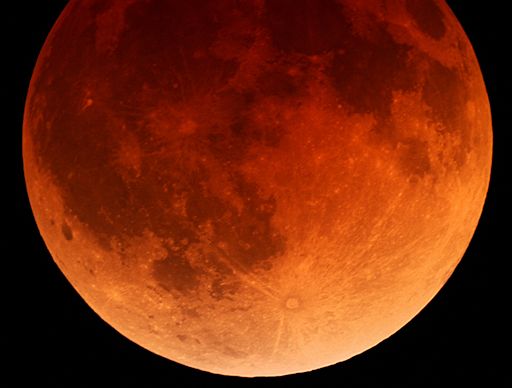On October 8th there will be a total eclipse of the Moon. Got clouds? No problem. The event will be broadcast live on the web by the Coca-Cola Science Center. | | |
ADVICE NEEDED: Are you an experienced photographer of lunar eclipses? You may be able to help the students of Earth to Sky Calculus. Tonight, using a helium balloon, the group will launch a Nikon D7000 to photograph the eclipse from the stratosphere. In ground tests, they have successfully photographed the un-eclipsed Moon with the camera set to F5.4, ISO 200, 1/1000s. How should these settings be adjusted, if at all, for the eclipse? Email your recommendations to Dr. Tony Phillips.
DON'T MISS THE LUNAR ECLIPSE: On Wednesday morning, Oct. 8th, there will be a total lunar eclipse. Sky watchers in the Americas, Australia and most of Asia can see the full Moon turn red as it passes through the sunset-colored shadow of Earth: visibility map. The show begins at approximately 9:15 UT (2:15 a.m. PDT) when the Moon makes first contact with the core of Earth's shadow. Totality, when the Moon is fully shadowed, begins at 10:25 UT (3:25 a.m. PDT) and lasts for nearly an hour. Resources: NASA video, animated eclipse, live webcast.
During the eclipse, the Moon will look like this:

The hue of the lunar disk may seem puzzling to some readers. Shadows are supposed to be black, yet the shadowed Moon is mostly bright red. A quick trip to the Moon explains the color:
Imagine yourself standing on a dusty lunar plain looking up at the sky. Overhead hangs Earth, nightside down, completely hiding the sun behind it. The eclipse is underway. You might expect Earth seen in this way to be utterly dark, but it's not. The rim of the planet is on fire! As you scan your eye around Earth's circumference, you're seeing every sunrise and every sunset in the world, all of them, all at once. This incredible light beams into the heart of Earth's shadow, filling it with a coppery glow and transforming the Moon into a great red orb.
Red isn't the only color, however. Sharp-eyed observers might also spot some turquoise, shown here in a photo taken by Jens Hackman during an eclipse in March of 2007:

Its source is ozone. Atmospheric scientist Richard Keen of the University of Colorado explains: "During a lunar eclipse, most of the light illuminating the moon passes through the stratosphere where it is reddened by scattering. However, light passing through the upper stratosphere penetrates the ozone layer, which absorbs red light and actually makes the passing light ray bluer." This can be seen, he says, as a soft blue fringe around the red core of Earth's shadow.
To catch the turquoise on Oct. 8th, he advises, "look during the first and last minutes of totality. The turquoise rim is best seen in binoculars or a small telescope."
Realtime Eclipse Photo Gallery
QUIET SUN: Solar activity is low, and the quiet is likely to continue. Not one of the six sunspot groups on the disk of the sun has the type of unstable magnetic field that poses a threat for strong eruptions. NOAA forecasters estimate a scant 5% chance of M-flares on Oct. 7th. Solar flare alerts: text, voice
Realtime Space Weather Photo Gallery
Realtime Aurora Photo Gallery
Realtime Comet Photo Gallery
Every night, a network of NASA all-sky cameras scans the skies above the United States for meteoritic fireballs. Automated software maintained by NASA's Meteoroid Environment Office calculates their orbits, velocity, penetration depth in Earth's atmosphere and many other characteristics. Daily results are presented here on Spaceweather.com.
On Oct. 7, 2014, the network reported 173 fireballs.
(169 sporadics, 2 Southern Taurids, 2)

In this diagram of the inner solar system, all of the fireball orbits intersect at a single point--Earth. The orbits are color-coded by velocity, from slow (red) to fast (blue). [Larger image] [movies]
Potentially Hazardous Asteroids (
PHAs) are space rocks larger than approximately 100m that can come closer to Earth than 0.05 AU. None of the known PHAs is on a collision course with our planet, although astronomers are finding
new ones all the time.
On October 7, 2014 there were potentially hazardous asteroids.
Notes: LD means "Lunar Distance." 1 LD = 384,401 km, the distance between Earth and the Moon. 1 LD also equals 0.00256 AU. MAG is the visual magnitude of the asteroid on the date of closest approach. | | The official U.S. government space weather bureau |
| | The first place to look for information about sundogs, pillars, rainbows and related phenomena. |
| | Researchers call it a "Hubble for the sun." SDO is the most advanced solar observatory ever. |
| | 3D views of the sun from NASA's Solar and Terrestrial Relations Observatory |
| | Realtime and archival images of the Sun from SOHO. |
| | from the NOAA Space Environment Center |
| | the underlying science of space weather |

